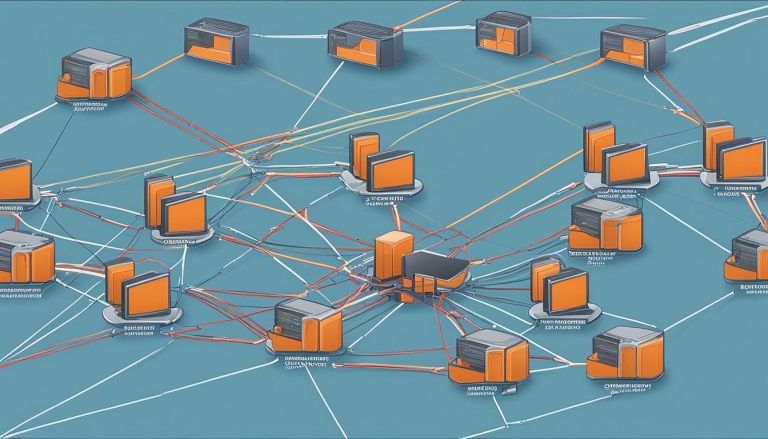Welcome to the world of home automation, where technology meets convenience and efficiency. In this article, I will explore the concept of home automation, its benefits, and the challenges it presents. Whether you’re a tech enthusiast or someone looking to streamline your home, understanding home automation is the first step towards creating a smart and connected living space.
So, what exactly is home automation? It’s the use of advanced technology to automate and manage various systems and devices within a home. Imagine controlling your lighting, heating, cooling, security systems, and other appliances through a single app or interface. That’s the power of home automation.
Home automation systems can range from simple setups that control a few devices to complex systems that integrate multiple technologies. With the help of smart devices like thermostats, lighting, locks, and appliances, homeowners can create a personalized and seamless home environment. The benefits of home automation are vast, including increased convenience, energy efficiency, enhanced security, and improved comfort.
Throughout this article, we’ll delve deeper into the world of home automation, exploring the technology behind it, the challenges you may face during setup, and the incredible advantages it brings to your daily life. Let’s embark on this journey together and unravel the mysteries of home automation.
Key Takeaways:
- Home automation is the use of advanced technology to control various systems and devices in a home through a single app or interface.
- Smart devices like thermostats, lighting, locks, and appliances are connected to a central hub, allowing for seamless control and customization of the home environment.
- The benefits of home automation include increased convenience, energy efficiency, enhanced security, and improved comfort.
- Setting up a smart home may pose challenges such as choosing compatible devices, network optimization, and troubleshooting technical issues.
- Thorough research, planning, and accessing reliable resources are crucial in overcoming the challenges and creating a seamless smart home setup.
The Challenges of Setting Up a Smart Home
Setting up a smart home can be a thrilling endeavor, but it also comes with its fair share of challenges and obstacles. From technological hurdles to connectivity issues, homeowners may encounter various difficulties along the way. Here are some of the key challenges that individuals may face when embarking on the journey of setting up a smart home:
1. Overwhelming Range of Devices: The market is flooded with an extensive array of smart home devices, each offering different features and functionalities. This wide range of options can make it challenging for homeowners to choose the right devices that meet their specific needs and preferences.
2. Confusion of Multiple Interfaces: Each smart device usually requires its own dedicated app or control system. This can lead to a cluttered smartphone screen and a less-than-optimal user experience, as homeowners struggle to manage and control multiple devices with different interfaces.
3. Connectivity and Syncing Difficulties: Ensuring seamless communication and synchronization between smart devices can sometimes be problematic. Connectivity issues, Wi-Fi problems, and syncing difficulties can arise, making it frustrating for homeowners to get all devices working harmoniously together.
4. Voice Command Challenges: While voice control has become a popular feature in smart home devices, it is not without its challenges. Misinterpreted commands and unexpected device responses can lead to confusion and frustration, diminishing the overall user experience.
5. Privacy and Security Concerns: The increasing integration of smart devices into our homes raises valid concerns about privacy and security. Homeowners must be mindful of potential vulnerabilities and take appropriate measures to secure their smart home systems from hacking attempts or data breaches.
6. Troubleshooting Frustrations: Like any technology, smart home devices may encounter technical issues or glitches. Troubleshooting these problems can be time-consuming and frustrating, particularly when homeowners lack the necessary technical expertise or access to reliable support resources.
Despite these challenges, with proper planning, research, and support, homeowners can overcome these obstacles and reap the benefits of a smart home system that offers convenience, energy efficiency, security, and personalized control over their home environment.
Table: Challenges of Setting Up a Smart Home
| Challenge | Description |
|---|---|
| Overwhelming Range of Devices | The vast selection of smart home devices can make it difficult for homeowners to choose the right ones for their needs. |
| Confusion of Multiple Interfaces | Managing and controlling multiple devices with different interfaces can be challenging and lead to a cluttered user experience. |
| Connectivity and Syncing Difficulties | Getting all smart devices to communicate and sync seamlessly can be a complex task, often resulting in connectivity issues. |
| Voice Command Challenges | Misinterpreted commands and unexpected device responses can diminish the effectiveness of voice control features. |
| Privacy and Security Concerns | Protecting personal data and securing smart home systems from potential breaches is a significant concern for homeowners. |
| Troubleshooting Frustrations | Addressing technical issues and glitches with smart home devices can be time-consuming and frustrating without proper support. |
The Benefits and Advantages of Home Automation
Home automation offers a wide range of benefits that can greatly improve the quality of life for homeowners. One of the key advantages is convenience. With home automation, you can control and manage all your devices and systems from a single app or interface. Whether you’re adjusting the lighting, setting the temperature, or even locking the doors, you have complete control at your fingertips.
Energy efficiency is another major benefit of home automation. Smart thermostats can learn your preferences and adjust the temperature accordingly, helping you save energy and reduce utility bills. Additionally, smart lighting systems can automatically turn off lights in unoccupied rooms, further reducing energy consumption. By optimizing the use of devices and systems, home automation enables you to save both energy and money.
Enhanced security is another advantage of home automation. With smart locks, you can remotely control and monitor access to your home, providing peace of mind and easy access control. Integrated security cameras and sensors offer real-time monitoring and immediate alerts for potential security breaches, ensuring the safety of your home and loved ones.
| Benefits of Home Automation | Keywords |
|---|---|
| Convenience | Convenience, remote monitoring and control, automation and scheduling |
| Energy Efficiency | Energy efficiency, energy savings |
| Security | Security |
| Comfort | Comfort |
| Cost Savings | Cost savings |
Comfort is also a significant benefit of home automation. By automating various aspects of your home environment, such as adjusting the lighting and temperature, you can create a customized and comfortable space that suits your preferences. Imagine coming home to a perfectly lit and cozy environment without having to manually adjust multiple devices.
Overall, home automation provides convenience, energy efficiency, enhanced security, and personalized comfort. With the ability to remotely monitor and control your home, create automation schedules, and save energy, homeowners can enjoy a more convenient and efficient lifestyle. By embracing home automation, you not only improve the functionality of your home but also enhance your overall well-being and peace of mind.
Smart Home Automation Companies and Technologies
When it comes to smart home automation, there are several prominent companies and technologies that are leading the way in providing innovative solutions for homeowners. Two notable companies in this field are Dwelo and SmartRent. Dwelo offers a comprehensive home automation platform that allows homeowners to control their lights, thermostat, and other connected devices through a single app. With features like device connectivity, automation, and remote control, Dwelo provides a seamless and convenient solution for smart home automation.
SmartRent, on the other hand, specializes in providing smart home automation solutions specifically designed for rental properties. Their platform allows property owners, managers, and tenants to easily manage their apartments and properties through a simple app. With features such as smart thermostats, lights, and locks, SmartRent offers an integrated and user-friendly solution that enhances the convenience and security of rental properties.
In terms of smart home technologies, Google Home integration and Nest compatibility are worth mentioning. Dwelo, for instance, offers integration with Google Home, allowing homeowners to control their smart devices through voice commands. This seamless integration expands the capabilities and functionality of the smart home setup, providing a more intuitive and hands-free user experience. Additionally, Dwelo is compatible with Nest, a leading smart home brand owned by Google. This compatibility allows homeowners to integrate Nest devices, such as thermostats and cameras, into their Dwelo smart home automation system, further enhancing their home’s automation capabilities.
| Company | Key Features |
|---|---|
| Dwelo | Comprehensive home automation platform |
| SmartRent | Specialized smart home automation for rentals |
In summary, smart home automation companies like Dwelo and SmartRent are at the forefront of providing cutting-edge solutions for homeowners and rental properties. With their innovative platforms and features, homeowners can enjoy the convenience, security, and energy efficiency that come with a smart home. Additionally, the integration of Google Home and compatibility with Nest devices further expand the capabilities and possibilities of smart home automation.
Overcoming the Challenges: Tips for Setting Up a Smart Home
Setting up a smart home can be an exciting yet challenging endeavor. To ensure a successful setup, it is essential to follow some valuable tips and strategies. The following are some key recommendations to overcome the challenges of setting up a smart home:
- Research and Planning: Before diving into the world of smart home automation, it is crucial to conduct thorough research and planning. Understand the different devices available, their features, and compatibility with each other and existing systems. This will help in selecting the right devices for your specific needs.
- Choose Compatible Devices: When selecting smart home devices, make sure to choose devices that are compatible with each other and can seamlessly integrate. This will simplify the setup process and ensure smooth communication between devices.
- Professional Installation vs. DIY Setup: Consider the complexity of the smart home system and decide whether to opt for professional installation or a DIY setup. Professional installation ensures that the devices are properly installed and integrated, while a DIY setup allows for greater customization and cost savings.
- Network Optimization: To minimize connectivity issues, optimize your home network. Ensure a strong Wi-Fi signal by placing the router in a central location and reducing interference from other devices. Proper network configuration is also crucial for seamless communication between smart devices.
- Firmware Updates: Keep your smart home devices’ firmware up to date. Firmware updates often include bug fixes, security patches, and performance improvements, ensuring that the devices are functioning optimally.
- Password Security: Protect your smart home devices and personal information by implementing strong password security. Create unique, strong passwords for each device and regularly update them. This will help prevent unauthorized access and hacking attempts.
- Privacy Measures: Safeguard your privacy by reviewing and understanding the privacy policies of your smart home devices. Disable unnecessary data sharing and enable privacy features whenever possible.
- Troubleshooting Resources: Familiarize yourself with troubleshooting resources such as online forums, manufacturer support, and professional technical assistance. These resources can be invaluable when encountering technical issues during the setup process.
By following these tips and leveraging the capabilities of smart home automation, you can overcome the challenges of setting up a smart home and enjoy the benefits and convenience it offers.
| Tip | Description |
|---|---|
| Research and Planning | Conduct thorough research and planning to understand different devices and their compatibility. |
| Choose Compatible Devices | Select smart home devices that are compatible with each other to ensure seamless integration. |
| Professional Installation vs. DIY Setup | Decide whether to opt for professional installation or a DIY setup based on the complexity of the system. |
| Network Optimization | Optimize your home network to minimize connectivity issues and ensure smooth communication between devices. |
| Firmware Updates | Keep your smart home devices’ firmware up to date to benefit from bug fixes and performance improvements. |
| Password Security | Create strong, unique passwords for each device and regularly update them to protect against unauthorized access. |
| Privacy Measures | Review privacy policies, disable unnecessary data sharing, and enable privacy features to safeguard personal information. |
| Troubleshooting Resources | Utilize online forums, manufacturer support, and professional technical assistance for troubleshooting assistance. |
Conclusion
Setting up a smart home can be both exciting and challenging. Despite the obstacles, the benefits of home automation make it a worthwhile endeavor. From increased convenience and energy efficiency to enhanced security and comfort, a smart home offers numerous advantages.
However, it’s important to be prepared for the challenges that may arise during the setup process. Choosing compatible devices, optimizing networks, keeping firmware up to date, and implementing password security and privacy measures are all key strategies for overcoming these hurdles.
By following these tips and leveraging the capabilities of smart home automation companies and technologies, homeowners can create a seamless and personalized home automation system. The journey of setting up a smart home is an investment in convenience, efficiency, and an improved quality of life.
FAQ
What is home automation?
Home automation is the use of advanced technology to automate and manage various systems and devices within a home. It allows homeowners to control their lighting, heating, cooling, security systems, and other appliances through a single app or interface.
What are the benefits of home automation?
The benefits of home automation include increased convenience, energy efficiency, enhanced security, and improved comfort. Home automation technology allows for seamless control and customization of devices, resulting in personalized control over the home environment.
What are some challenges of setting up a smart home?
Some challenges of setting up a smart home include the overwhelming range of smart devices available, confusion of multiple interfaces, connectivity issues, Wi-Fi problems, syncing difficulties, voice command challenges, privacy and security concerns, and troubleshooting frustrations.
What companies offer smart home automation solutions?
There are several prominent companies in the smart home automation industry, including Dwelo and SmartRent. Dwelo offers a comprehensive home automation platform, while SmartRent specializes in smart home solutions for rental properties. Both companies provide features such as device connectivity, automation, and remote control.
How can I overcome the challenges of setting up a smart home?
To overcome the challenges of setting up a smart home, it is important to conduct thorough research and planning, choose compatible devices, optimize networks, keep firmware up to date, implement password security and privacy measures, and access reliable troubleshooting resources.
Jana is a public relations specialist and writes about all kinds of software products that make our life easier.


